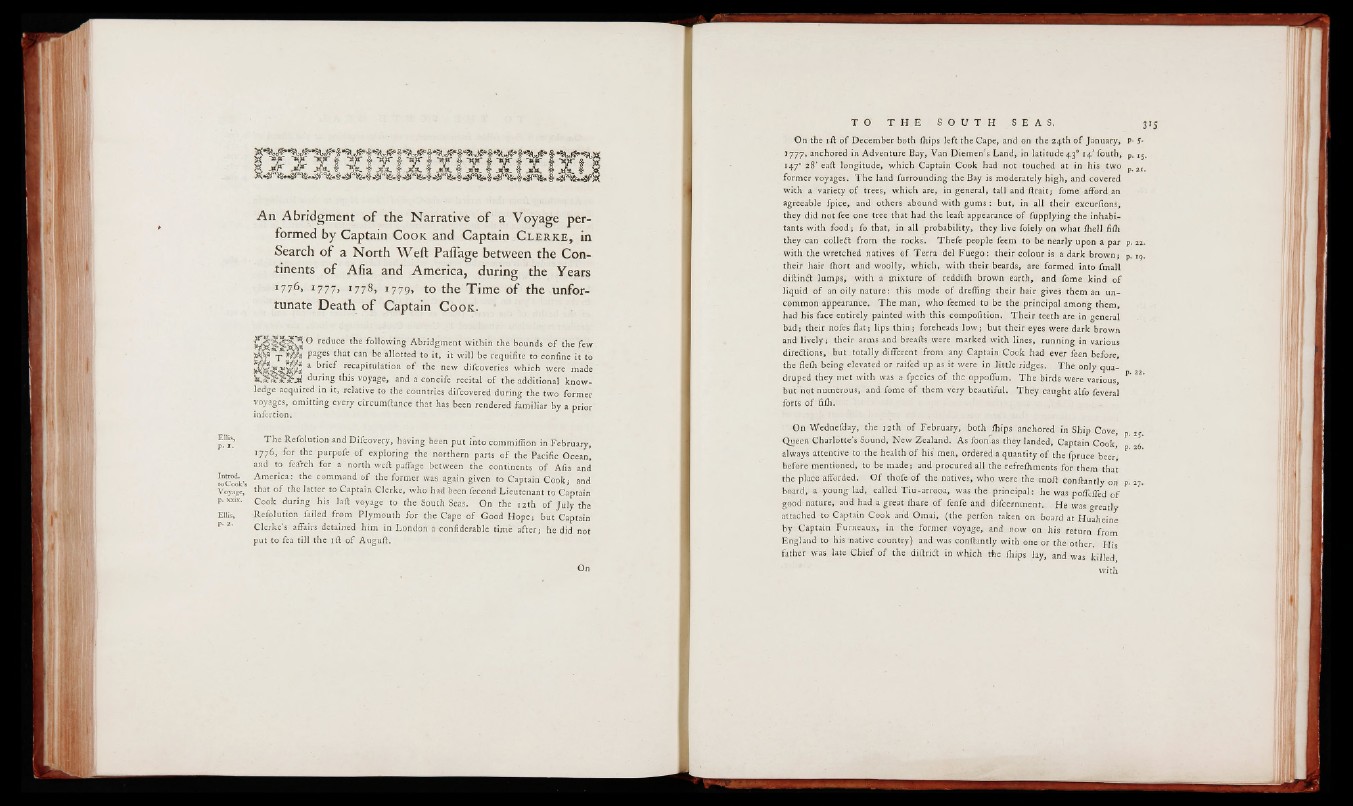
An Abridgment of the Narrative of a Voyage performed
by Captain C o o k and Captain C l e r k e , in
Search of a North Weft Paflage between the Continents
of Afia and America, during the Years
i 776> i 77 7> 1778, 1779) to the Time of the unfortunate
Death of Captain C o o k .
° reduce the following Abridgment within the bounds of the few
y Wfli PaSes *bat can be allotted to it, it will be requiiite to confine it to
a ^)r'C^' recapaulation of the new difcoveries which were made
k 8 3 f 3fjt! during this voyage, and a concife recital of the additional knowledge
acquired in it, relative to the countries difcovered during the two former
voyages, omitting every circumftance that has been rendered familiar by a prior
infertion.
Ellis, The Refolution and Difcovery, having been put into commiffion in February,
1776, for the purpofe.of exploring the northern parts of the Pacific Ocean,
and to feafch for a north weft paflage between the continents of Afia and
MC0ik' America: the command of the former was, again given to Captain Cook; and
Voyage, that of the latter to Captain Clerke, who had been fecond Lieutenant to Captain
p.xxix. Cook during his laft voyage to the South Seas. On the 12th of July the
Ellis, Refolution failed from Plymouth for the Cape of Good Hope; but Captain
p' 2' Clerke’s affairs detained him in London a confiderable time after; he did not
put to fea till the i it of Auguft.
On
On the 1 ft of December both ihips left the Cape, and on the 24th of January, P- 5*
1777, anchored in Adventure Bay, Van Diemen’s Land, in latitude 43° 14’ fouth, p. 15.
1470 28’ eaft longitude, which Captain Cook had not touched at in his two p, 2i.
former voyages. The land furrounding the Bay is moderately high, and covered
with a variety of trees, which are, in general, tall and ftrait; fome afford an
agreeable fpice, and others abound with gums: but, in all their excurfions;
they did not fee one tree that had the leaft appearance of fupplying the inhabitants
with food j fo that, in all probability, they live folely on what ihell fifh
they can colledl from the rocks. Thefe people feem to be nearly upon a par p. 22.
with the wretched natives of Terra del Fuego: their colour is a dark brown j p. 19.
their hair ihort and woolly, which, with their beards, are formed into fmall
diftindt lumps, with a piix.ture of reddiih brown earth, and fome kind of
liquid of an oily nature: this mode of drefling their hair gives them an uncommon
appearance. The man, who feemed to be the principal among them,
had his face entirely painted with this compofition.. Their teeth are in general
bad; their nofes flat; lips thin; foreheads low; but their eyes were dark brown
and lively; their arms and breafts were marked with lines, running in various
directions, but totally different from any Captain Cook had ever feen before
the flefh being elevated or raifed up as it were in little ridges. The only quadruped
they'met with was a- fpecies of the oppofium. The birds were various * -
but not numerous, and fome of them very beautiful. They caught alio feveral
forts of fifh.
On Wednefday, the 12th of February, both ihips anchored in Ship Cove, 2<
Queen Charlotte’s Sound, New Zealand. As foomas they landed, Captain Cook g*
always attentive to the health of his' men, ordered a quantity o f the fpruce beer
before mentioned, to be made; and procured all the refrefhments for them that
the place afforded. O f thofe of the natives, who were the moft conftantly on p. 27.
board,- a young lad, called Tiu-arrooa, was the principal: he was poifcifed of
good nature, and had a great fhare of fenfe and difcernment. He was greatly
attached to Captain Cook and Omai, (the perfon taken on board at Huaheine
by Captain Furneaux, in the former voyage, and now on his return from
England to his native country) and was conftantly with one or the other His
father was late Chief of the diftridt in which the ihips lay, and was killed
with